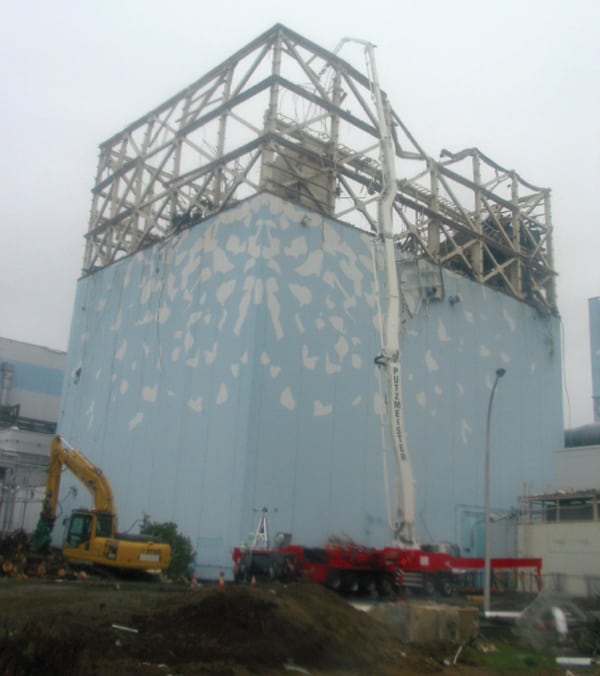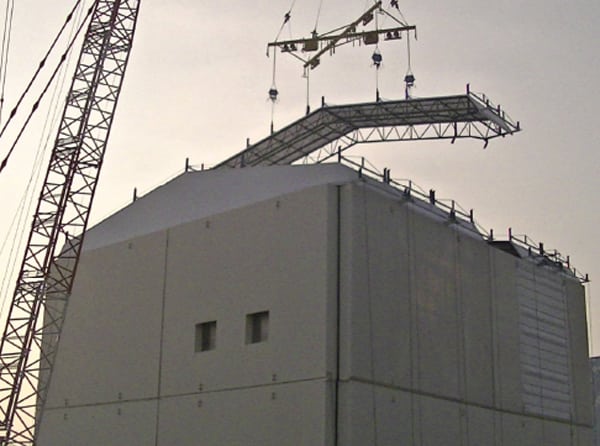Airtight Cover Completed for Daiichi 1
Tokyo Electric Power Co.’s (TEPCO’s) Fukushima Daiichi 1 reactor—a unit that suffered a core melt and hydrogen gas explosion after the March 11 earthquake in Japan and subsequent tsunami devastated the six-reactor facility (Figure 5)—was fully encased in an “airtight” cover in October (Figure 6). The temporary measure will prevent diffusion of radioactive materials—including those discharged from water vapor from spent fuel pools, rubble, and dust—and prevent rain from entering the reactor building, TEPCO said.
 |
| 5. The blast in the past. The Fukushima Daiichi 1 reactor building is seen here on May 24, 2011, surrounded by concrete pumper trucks that sprayed water on spent fuel pools and carried airborne contamination sampling equipment. The reactor’s core melted just five hours after the deadly March 11 earthquake, setting off a hydrogen explosion that devastated its containment building. Similar explosions occurred at Units 2, 3, and 4. Courtesy: TEPCO |
 |
| 6. A polyester shroud. Plant owner Tokyo Electric Power Co. (TEPCO) achieved a milestone in October when it covered Daiichi 1 with vinyl chloride resin–coated roof panels and wall panels that are made of polyester fiber fabric. The structure will prevent diffusion of radioactive materials and keep out rain, TEPCO said, adding that the cover marks a milestone in its restoration roadmap. It will now embark on a longer-term measure, likely entombing the reactor in concrete. |
The cover is essentially made up of a steel frame structure covered by vinyl chloride resin–coated roof panels and wall panels that are made of polyester fiber fabric. It measures 54 meters (177 feet) high, 47 meters (154 feet) wide, and 42 meters (132 feet) deep and has a ventilation system that filters out radioactive substances. TEPCO says the cover, similar designs of which will eventually be built around Units 3 and 4, is engineered to keep the reactor safe against high winds and tremors, though it notes it could be damaged by a “huge typhoon.”
TEPCO has been building the casing for the damaged reactor building since June. Major components were constructed at Onagawa and shipped to the Daiichi site by sea for assembly around the reactor building. During pilot tests, the ventilation system removed more than 90% of radioactive cesium from the reactor, TEPCO said. The company is considering installing similar covers over both Daiichi 3 and Daiichi 4 when debris removal is completed after next summer.
Covering the reactor building marks a major milestone for TEPCO, which will now begin the detailed design of a more permanent measure to contain radioactive materials. Plans involve building a concrete sarcophagus for the reactor—possibly similar to the one built to protect Chernobyl’s Unit 4. Analysts point out, however, that the Chernobyl sarcophagus is aging and crumbling, and that measures are under way to replace it with a $1.4 billion steel containment structure.
Meanwhile, according to the beleaguered plant owner, progress is being made to achieve cold shutdown of Daiichi Units 1, 2, and 3 by the end of the year, in line with a schedule set in an April-issued restoration roadmap. The company is removing radioactive materials from Unit 2’s containment vessel, a reactor that suffered minor damage to its containment building, but whose core saw the most damage. Debris is also being removed at Units 3 and 4.
Japan’s Atomic Energy Commission in late October said it would begin retrieving melted nuclear fuel rods from Units 1, 2, and 3 within 10 years. The commission also plans to move spent fuel rods from pools at Units 1 and 4 to another pool in the plant within three years.
TEPCO continues imploring Japan’s government for 900 billion yen ($11.85 billion) in financial assistance to aid compensation to individuals and entities affected by the nuclear disaster. The government is already required by the Nuclear Damage Compensation Law to pay a maximum of 120 billion yen ($1.5 billion) in compensation. The government’s decision is expected in early November.
Nearly nine months after the devastating earthquake, 44 of Japan’s 55 existing nuclear reactors, continue to be in shutdown for regulatory scrutiny. Eighteen reactors are currently undergoing government-mandated stress tests, and of the 10 reactors still running, at least four are expected to be shut down for routine inspections by the year’s end. The remaining six will go offline by early next year—which could leave Japan with the possibility of having no active nuclear plants next year.
—Sonal Patel is POWER’s senior writer